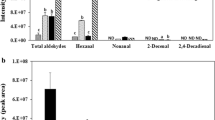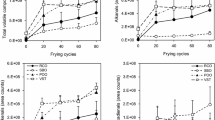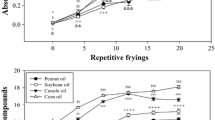Abstract
New legislation introduced in South Africa for the quality of used frying oils has resulted in the need to identify quicker, more suitable methods that correlate well with results from two official methods, namely, total polymerized glycerides and total polar components. Oil and product samples were taken at regular intervals during a commercial frying process in palm olein. Oil samples were analyzed for a number of different quality parameters viz. tocopherol content, dielectric constant, total polymerized glycerides, total polar components, tertiary butylhydroquinone (TBHQ) content, anisidine value, Rancimat induction period, and free fatty acid content, and the results statistically compared to results from official methods. Oil was expressed from product stored under accelerated conditions and analyzed for the same quality parameters. Fried product was also subjected to sensory evaluation to measure the degree of oil deterioration and sensory preference. The frying trial was successfully executed with refined, bleached, and deodorized palm olein and the frying oil used to a free fatty acid (FFA) content of 0.41%. Oil and product sampling were done at different FFA value levels. Frying oil quality was verified at the onset of the trial and at regular intervals. The frying oil total polar component value increased to approximately half of the limit set by the official regulation. This point was reached mainly due to the high starting value of the fresh oil. Frying oil total polymerized glycerides increased from below 1% to 2.1%. This increase is negligible when compared to the general trend for polyunsaturated oils. The alternative laboratory methods used for predicting oil quality can be rated as follows: total tocopherol content >dielectric constant >FFA >TBHQ content >anisidine value >Rancimat induction period. The first three methods correlated well with total polar component levels and it is recommended that the dielectric constant and FFA measurements be applied for monitoring oil condition during frying. It is possible that viscosity changes could be used for the monitoring of polyunsaturated frying oils. Evaluation of oil extracted from product revealed a negligible effect of non-oil components on oil quality parameters. The same was observed when product was stored at −10°C and at 37°C.
Similar content being viewed by others
References
Foodstuffs, Cosmetics and Disinfectants Act (South Africa). 1972 (Act 54 of 1972). Regulations prohibiting chemicals in vegetable oil (April 1996).
Beljaars, P.R., R. Van Dijk, and A.A.M. Houwen-Claassen, Determination of Polymerized Triglycerides in Frying Fats and Oils by Gel Permeation Chromatography: Interlaboratory Study, J. Assoc. Off. Anal. Chem. 77:667–671 (1994).
IUPAC-AOAC Method, AOAC Official Methods of Analysis, 982.27, 968–969, 1990.
FOODOIL SENSOR Model N1-21 measures dielectric constant, U.S. Patents 3,746,974 and 3,739,265.
Animal and Vegetable Fats and Oils-Determination of Anisidine Value. ISO/DIS 6885, 1–3.
AOCS Official Method Ca 5a-40, Free Fatty Acids, in Official Methods and Recommended Practices of the American Oil Chemists’ Society, 3rd edn., American Oil Chemists’ Society, Champaign, 1977.
Analytical Method AM 033, Determination of Vitamin E, Food Quality Programme, 3-9-1993, Revision A.
Van Niekerk, P.J., The Direct Determination of Free Tocopherols in Plant Oils by Liquid-Solid Chromatography, Anal. Biochem. 52:533–537 (1973).
Van Niekerk P.J., and L.M. du Plessis, The Application of Liquid Chromatography to Food Analysis, SA Food Review 3:167–171 (1976).
Analytical Method AM 074, TBHQ Analysis, Food Quality Programme, 20-8-1996, Revision A.
Van Niekerk, P.J., and L.M. du Plessis, High-Performance Liquid Chromatographic Determination of tert-Butylhydroquinone in Vegetable Oils, J. Chromatogr. 187:436–438 (1980).
AOCS Official Method Cd 8-53, Peroxide Value, in Official Methods and Recommended Practices of the American Oil Chemists’ Society, 3rd edn., American Oil Chemists’ Society, Champaign, 1986.
Allen, J.C., and R.J. Hamilton, Rancidity in Foods, 3rd edn., Blackie Academic and Professional, London, 1994.
Warner, K., and N.A.M. Eskin, Methods to Assess Quality and Stability of Oils and Fat-containing Foods, AOCS Press, Champaign, 1995.
Augustin, M.A., Asap Telingai, and L.K. Heng, Relationships Between Measurements of Fat Deterioration During Heating and Frying in RBD Olein, J. Am. Oil Chem. Soc. 64:1670–1675 (1987).
Marquez-Ruiz, G., M. Tasioula-Margari, and M.C. Dobarganes, Quantitation and Distribution of Altered Fatty Acids in Frying Fats, Ibid.:1171–1176 (1995).
Arroyo, R., C. Cuesta, J.M. Sanchez-Montero, and F.J. Sanchez-Muniz, High-Performance Size Exclusion Chromatography of Palm Olein Used for Frying, Fett Wissen. Technol. 97:292–296 (1995).
du Plessis, L.M., and W.H. Marais, Measuring Frying Oil Utilization, Poster presentation 13th Biennial SAAFOST Congress, August/September 1995.
du Plessis, L.M., P. Van Twisk, P.J. Van Niekerk, and M. Steyn, Evaluation of Peanut and Cottonseed Oils for Deep Frying, J. Am. Oil Chem. Soc. 58:575–578 (1981).
du Plessis, L.M., Frying Oil Quality Parameter Changes, Proceedings of the Food Applications session of the 22nd World Congress of the ISF, Kuala Lumpur, Malaysia, 7–12 September 1997.
Paul, S., and G.S. Mittal, Regulating the Use of Degraded Oil/Fat in Deep-Fat/Oil Food Frying, Crit. Rev. Food Sci. Nutri. 37:635–662 (1997).
Author information
Authors and Affiliations
Corresponding author
About this article
Cite this article
du Plessis, L.M., Meredith, A.J. Palm olein quality parameter changes during industrial production of potato chips. J Amer Oil Chem Soc 76, 731–738 (1999). https://doi.org/10.1007/s11746-999-0168-2
Received:
Accepted:
Issue Date:
DOI: https://doi.org/10.1007/s11746-999-0168-2




